Zapad: What can we learn from Russia's latest military exercise?
 Getty Images
Getty ImagesFor all the Western concern about Russia's Zapad military exercises, they nonetheless offer a rare insight into developments in the Russian military at a time of significant change.
As one of the leading Western analysts of Russian military developments, Roger McDermott, says, "while Russia's armed forces' leadership remain very interested in military theory, they test and rehearse new approaches to warfare in strategic exercises".
Thus, he adds, "exercises like Zapad offer glimpses into the real level of capability and demand careful and sober assessment for outsiders".
Russia claims this exercise falls below a treaty threshold of 13,000 soldiers that would require invitations to be issued to observer teams from other European nations. Western analysts place the numbers involved much higher.
But even without full-scale observer teams, Zapad is being monitored closely by Nato countries using satellites and aircraft with radars that can reach into western Russia to get a clear sense of how Russian and Belarussian forces perform.
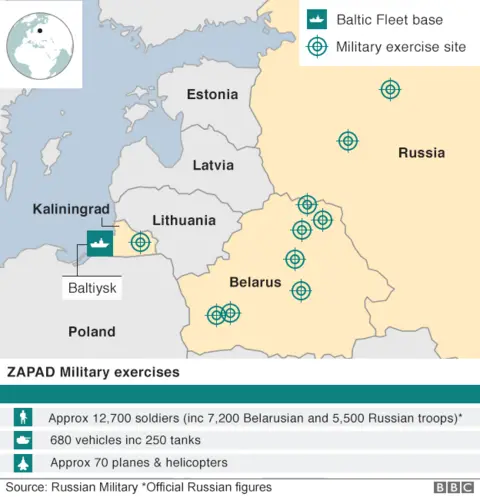
These exercises come at an interesting moment.
The Russian military is transitioning from the old Cold-War-style Red Army into a more modern and flexible force, capable of conducting combined operations across land, sea and air, tailored to a variety of potential scenarios - just like the more sophisticated of Nato armies.
Lessons learned?
Igor Sutyagin, the senior research fellow for Russian studies at the Royal United Services Institute for Defence and Security Studies (RUSI) think tank in London, describes this as an attempt to create "a lean, fully manned, combat-ready force, fully - or to the best possible extent - equipped with the up-to-date equipment [and] supported by agile rear infrastructure".
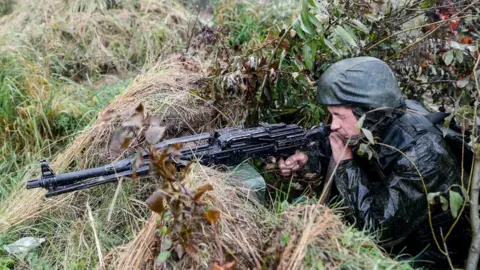 EPA
EPADespite Russia's victory in the brief Georgia war of 2008, the conflict showed up many shortcomings. And Western analysts will be watching the Zapad manoeuvres closely to see how the Russian General Staff is applying the lessons learned from more recent operations in Syria and eastern Ukraine.
Dr Sutyagin told me: "Both campaigns showed the general direction in which the Russian military is moving."
But how far has Russia's military transition really gone? And, crucially, will the Russian government continue to have sufficient funds to maintain its military modernisation plans?
Technological gap?
Dr Sutyagin says the transition has passed the middle of its long path, with organisational changes nearing their completion.
However, there have been some indications of backsliding, with a return to the establishment of large army divisions which, he says, are "hard to man, thus being to a large extent 'empty shells'".
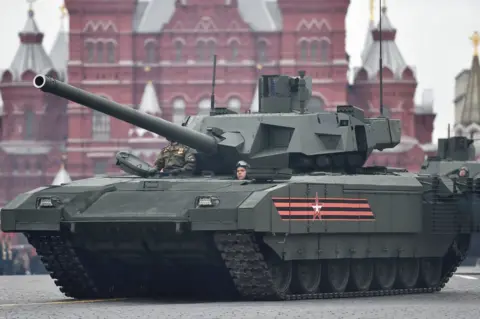 AFP
AFPRearmament with modern weaponry, necessary to close - or at the minimum, narrow - the technological gap between the Russian and the best Western military forces is also gaining momentum.
But Dr Sutyagin says much of the new equipment budget may now be in question, "as completion of the rearmament programme depends on both availability of finances and access to Western technologies, which is becoming harder".
Spectacular fire power
In terms of the Zapad exercises themselves, there is much to look for.
In theory these are defensive exercises, organising the defence of Russia and Belarus against an external attack.
 EPA
EPAThis of course has not prevented some spectacular firepower demonstrations, not least the firing of an Iskander-M missile from a range in south-west Russia against a mock target in Kazakhstan - a flight of some 480km (300 miles).
But in terms of the exercises themselves, what will Nato watchers be looking for?
Mr McDermott says "it will be worth examining the use of strike systems in the exercise" because "since the last Zapad in 2013, Moscow has magnified the role of conventional precision strike in its set of coercive tools".
In a ground-breaking study of Russia's use of what it calls "high-precision weapons" (precision-guided munitions or PGMs in the West) recently published by the Norwegian Defence Research Establishment, Mr McDermott and his co-author, Tor Bukkvoll, set out the history and development of Russia's interest in this category of weapon.
Long-range cruise missiles, both air- and sea-launched, were first used by the Russians in combat in the conflict in Syria.
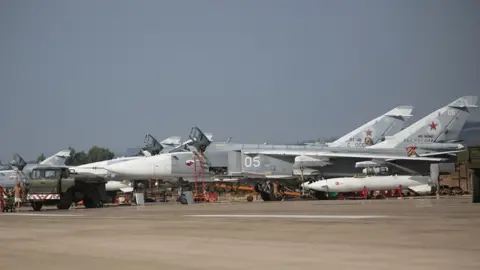 AFP
AFPIt is interesting that while much of the Western media discussion of PGMs rests upon their use as air-launched weapons in bombing campaigns, intended to increase accuracy and reduce the level of civilian casualties, in Russia the weapons are viewed in a rather different light.
Mr McDermott's study concludes that "for the foreseeable future, precision-guided munitions will mainly provide Russia with what in the Russian literature is called a 'pre-nuclear' deterrence capability".
Electronic warfare
Note the Iskander-M launch in this exercise. This is basically just another layer of deterrence in addition to the nuclear weapons, but is still seen as being of vital importance by the Russian military.
Another area Mr McDermott highlights is Russia's growing electronic warfare (EW) capability.
This has been on display during the fighting in eastern Ukraine and has impressed many Nato commanders.
They fear that while their forces have had a lengthy gap in serious training for high-intensity conflict to fight counter-insurgency campaigns in Iraq and Afghanistan, Russia has been steadily improving its forces. EW is a case in point.
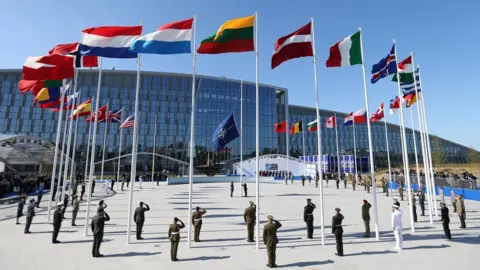 Reuters
ReutersIn a recently published study for the International Centre for Defence and Security in Estonia, Mr McDermott said: "Russia's growing technological advances in EW will allow its forces to jam, disrupt and interfere with Nato communications, radar and other sensor systems, unmanned aerial vehicles and other assets."
This capability, he said, risked "negating advantages conferred on [Nato] by its technological edge".
"Many of those systems," he said, "are being introduced in units across all services stationed in Russia's Western Military District adjacent to Nato's borders."
Russia sees EW as a seamless whole, ranging from kinetic combat operations on the battlefield to missions in cyber-space and the information domain.
Indeed this may be the area where the Russian military is breaking the "newest" ground, having as it does, a far less clearly defined sense of the boundary line between war and peace.
It is in this "grey area" of warfare that Moscow is leveraging its abilities.
As such it poses fundamental political and military challenges to Nato countries, in whose strategic outlook war and peace tend to assume a far more black and white character.
